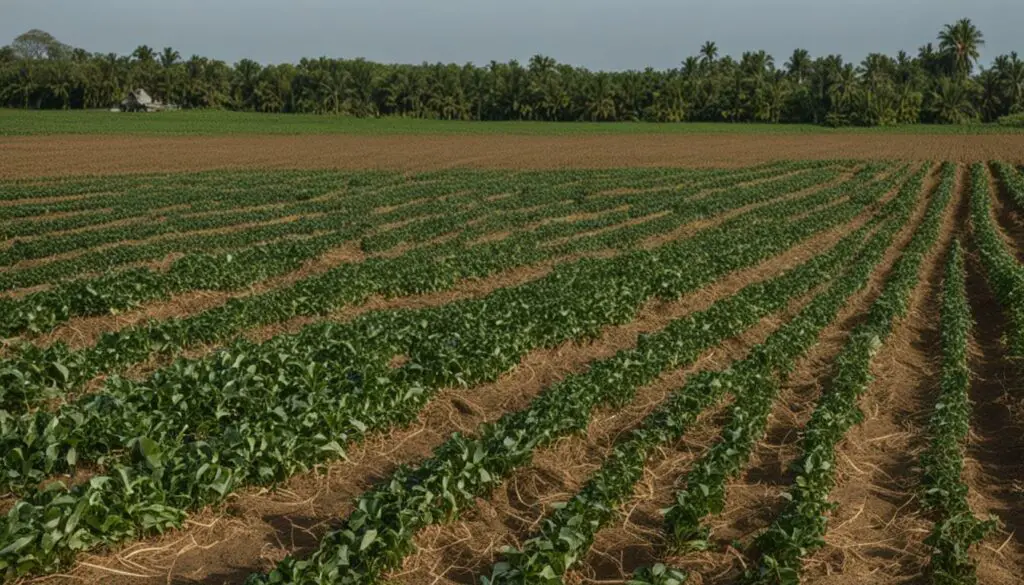Originally posted on December 14, 2023 @ 8:23 pm
Are you curious about how food stamps are funded? Understanding the funding sources for the food stamps program, officially known as the Supplemental Nutrition Assistance Program (SNAP), can shed light on this important federal food program in the United States. With nearly 46 million people relying on SNAP benefits to access $70 billion worth of groceries, it’s crucial to know where the funding comes from.
Table of Contents
Key Takeaways:
- SNAP, or the food stamps program, is the largest federal food program in the United States.
- The program helps combat food insecurity by providing individuals with $70 billion in SNAP benefits.
- SNAP is funded through a combination of federal and state resources.
- The federal government covers the full cost of SNAP benefits, while the states share the administrative costs.
- Understanding the funding sources for SNAP is crucial in addressing food security and hunger in the United States.
History of Food Stamps Program

The history of food stamps traces back to the 1930s when nutrition assistance programs were first introduced. However, it was not until 1964, as part of President Johnson’s War on Poverty, that the modern food stamps program was established. Designed to improve the nutrition of low-income families and support the domestic agricultural economy, the program has evolved significantly over the years.
One of the most significant milestones in the evolution of the food stamps program was the transition from paper vouchers to electronic benefits transfer (EBT) cards in 2008. This switch improved the efficiency and accessibility of the program, allowing recipients to conveniently and discreetly access their benefits. Today, the electronic transfer system is an integral part of the program, facilitating the distribution of food assistance to millions of eligible households.
Throughout its history, the food stamps program has been shaped by economic, political, and social factors. Its primary goal remains to provide vital food assistance to those in need, reducing food insecurity and supporting individuals and families in their pursuit of a nutritious and balanced diet.
Snap Today

The Food Stamp Act of 1977 laid the foundation for the current structure of the SNAP program. This program provides automatic eligibility for low-income individuals who meet specific income and asset requirements. SNAP benefits are designed to be counter-cyclical, meaning they expand during economic downturns and contract during periods of economic growth. This flexibility allows the program to respond to the changing needs of individuals and families.
The Structure of SNAP
The SNAP program operates through a partnership between the federal government and state governments. The federal government bears the entire cost of SNAP benefits, ensuring that eligible individuals and families receive the necessary support to meet their nutritional needs. On the other hand, administrative costs are shared between the federal and state governments, creating a collaborative effort to deliver the program effectively.
Automatic Eligibility
SNAP provides automatic eligibility for individuals and families who meet the income and asset requirements. This streamlined process helps ensure that those in need can access SNAP benefits without facing unnecessary delays or barriers. It is important to note that eligibility criteria may vary slightly from state to state, but the overall goal remains consistent – to support those with limited financial resources.
Expansions and Contractions
SNAP benefits expand or contract based on the state of the economy. During times of economic downturns, when more individuals and families experience financial strain, SNAP benefits automatically increase to provide additional assistance. Conversely, during periods of economic growth, the program contracts to align with reduced need. This flexibility allows SNAP to effectively respond to changing circumstances and ensure the efficient distribution of benefits.
Shared Responsibility
The funding and administration of SNAP are shared responsibilities between the federal and state governments. The federal government establishes and funds the program, while state governments play a crucial role in implementing and managing SNAP at the local level. This collaborative approach allows for tailored solutions that address both nationwide challenges and unique regional needs.
| Responsibility | Federal Government | State Governments |
|---|---|---|
| Funding SNAP benefits | 100% | N/A |
| Administering costs | Shared with states | Shared with federal government |
SNAP: A collaboration between federal and state governments to provide vital nutrition assistance to individuals and families in need.
Snap Policy Themes

The Supplemental Nutrition Assistance Program (SNAP) has long been subject to debates and discussions surrounding various policy themes. These themes include ensuring access to food benefits, food restrictions within the program, and the adequacy of the Thrifty Food Plan.
“We must ensure that all individuals and families have access to the food benefits they need to maintain their health and well-being. SNAP plays a crucial role in fighting hunger and reducing food insecurity,” says Emma Johnson, a food policy advocate.
One ongoing debate revolves around the idea of implementing restrictions on certain food purchases made with SNAP benefits. Proponents argue that these restrictions can promote healthier eating habits and prevent the misuse of funds. However, opponents argue that imposing restrictions infringes upon individual freedom and the right to choose what to buy.
Another topic of discussion is the adequacy of the Thrifty Food Plan, which serves as the basis for calculating SNAP benefits. Critics argue that the Thrifty Food Plan may not accurately reflect the nutritional needs and costs of 21st-century households. They highlight the importance of reassessing and adjusting the plan to better meet the diverse needs of SNAP recipients.
Snap Policy Themes Overview:
- Ensuring access to food benefits
- Debates on food restrictions in SNAP
- The adequacy of the Thrifty Food Plan
In order to address these policy themes and ensure an effective and efficient SNAP program, policymakers must engage in ongoing discussions and consider perspectives from a diverse range of stakeholders.
| Policy Theme | Key Points |
|---|---|
| Access to food benefits | – Ensuring equitable distribution of SNAP benefits – Addressing barriers to access – Enhancing outreach and education programs |
| Food restrictions in SNAP | – Balancing public health goals with individual choice – Exploring potential impacts on nutritional outcomes – Considering feasibility and cost-effectiveness of implementation |
| The adequacy of the Thrifty Food Plan | – Assessing the plan’s accuracy in reflecting current household needs – Evaluating the impact of inflation and food price fluctuations – Identifying strategies for adjusting the plan to better meet nutritional requirements |
Federal Funding for SNAP
Congress plays a crucial role in determining the funding and legislative framework for the Supplemental Nutrition Assistance Program (SNAP) through the farm bill, which encompasses various agricultural and rural development initiatives. As the largest federal food program in the United States, SNAP relies on federal funding to provide essential food assistance to millions of individuals and families in need.
Under the SNAP program, the federal government assumes the responsibility of covering the full cost of SNAP benefits, ensuring that eligible households receive the necessary support to access nutritious food. This federal funding not only helps combat food insecurity but also supports the overall well-being and health of vulnerable communities across the country.
In addition to funding SNAP benefits, the federal government shares the cost of administering the program with the states. This collaboration enables efficient program implementation and ensures that eligible individuals receive the necessary support in a timely manner.
The United States Department of Agriculture’s (USDA) Food and Nutrition Service (FNS) plays a critical role in the federal funding and oversight of SNAP. As the agency responsible for turning legislative language into program rules, the FNS ensures the proper implementation and operation of SNAP at the national level.
“SNAP plays a vital role in addressing food insecurity and providing a safety net for individuals and families in need. Through federal funding and collaboration with states, the program helps alleviate hunger and promotes access to nutritious food.”
To provide a clearer understanding of the funding allocation and distribution for SNAP, the table below breaks down the federal funding for the program in recent years:
| Year | Federal Funding for SNAP ($ billions) |
|---|---|
| 2018 | 64.7 |
| 2019 | 63.5 |
| 2020 | 71.2 |
| 2021 | 77.3 |
This table illustrates the increasing federal funding for SNAP over the years, demonstrating the government’s commitment to addressing the food needs of vulnerable populations.
Overall, federal funding is the backbone of the SNAP program, enabling the provision of essential food assistance to millions of individuals and families. Through collaborative efforts between the federal government, states, and agencies like the USDA’s FNS, SNAP continues to make a substantial impact in reducing food insecurity and improving the overall well-being of marginalized communities.
State Funding for SNAP

While the federal government covers the full cost of SNAP benefits, states also play a crucial role in funding and administering the program. As part of their responsibilities, states determine the eligibility for SNAP benefits and issue monthly allotments to eligible households. This allows them to ensure that individuals and families in need receive the support they require to purchase nutritious food.
Moreover, states have the flexibility to implement innovative practices and receive waivers to address specific needs within their jurisdictions. This enables them to tailor their approach to SNAP administration, taking into account unique local circumstances and demographics.
To support states in their efforts, the federal government provides funding for SNAP administration. This allocation helps cover the costs associated with determining eligibility, issuing benefits, and enforcing program integrity. Additionally, the federal government supports research and design of electronic benefit systems, facilitating efficient and secure implementation of SNAP benefits at the state level.
By collaborating with the federal government, states can ensure the effective implementation of SNAP, providing a safety net for individuals and families facing food insecurity. This joint effort allows for creativity and adaptation at the state level, contributing to the overall success of the program in addressing hunger and improving food security across the United States.
| State Funding for SNAP | Federal Funding for SNAP |
|---|---|
| Supports SNAP administration | Covers the full cost of SNAP benefits |
| Determines eligibility and issues monthly allotments | Shares administrative costs with states |
| Provides flexibility for innovative practices | Supports research and design of electronic benefit systems |
State Funding vs. Federal Funding
State funding for SNAP focuses on the administration and implementation of the program within individual states, while federal funding primarily covers the cost of SNAP benefits. Both state and federal funding are essential for the successful operation of SNAP, ensuring that eligible households receive the support they need to access nutritious food.
Snap Eligibility and Application Process

Ensuring access to food assistance through the Supplemental Nutrition Assistance Program (SNAP) is crucial for households facing financial hardship. To qualify for SNAP benefits, households must meet certain criteria. The eligibility requirements include having a gross monthly income at or below 130% of the federal poverty line. However, it is important to note that eligibility criteria may vary depending on the state and household composition.
When applying for SNAP benefits, households will go through an application process to determine their eligibility. This process involves assessing various factors, including household resources and income. Factors such as work earnings, bank accounts, and real estate ownership are taken into consideration during the evaluation. It is essential to provide accurate and up-to-date information during the application process to ensure a fair assessment of eligibility.
Exceptions to resource and income rules exist, and certain expenses may be deducted from the total household contribution. These exceptions and deductions help ensure that households with essential expenses can still receive the support they need through SNAP benefits. The application process may require households to provide documentation and complete forms that accurately reflect their financial situation.
Income Eligibility Guidelines
Income eligibility for SNAP benefits is determined based on the federal poverty guidelines. As of May 2021, the income limits for SNAP eligibility are as follows:
| Household Size | Maximum Gross Monthly Income |
|---|---|
| 1 | $1,383 |
| 2 | $1,868 |
| 3 | $2,353 |
| 4 | $2,839 |
| 5 | $3,324 |
Note: These income limits are subject to change and may vary depending on state-specific guidelines.
It is important for individuals and households in need of SNAP benefits to familiarize themselves with the specific eligibility requirements in their state. Eligibility guidelines and application processes may vary slightly from state to state, so it is essential to consult the official SNAP website or contact the local SNAP office for accurate and up-to-date information.
By ensuring eligibility requirements are met and providing accurate information during the application process, households can begin receiving much-needed SNAP benefits to alleviate food insecurity and improve their overall well-being.
SNAP Benefits and Allowed Purchases

The Supplemental Nutrition Assistance Program (SNAP) provides eligible individuals and families with electronic benefit transfer (EBT) cards that can be used to purchase a wide range of food items. These benefits are designed to supplement a family’s available food budget and ensure access to essential nutrition.
SNAP benefits can be used to purchase eligible food items, including:
- Fruits and vegetables
- Meat and poultry
- Dairy products
- Breads and cereals
Note: SNAP benefits cannot be used to purchase alcoholic beverages, cigarettes, vitamins, or nonfood grocery items.
The aim of SNAP benefits is to support individuals and families in need by providing them with the means to access a low-cost, nutritionally sound diet. By allowing the purchase of essential food items, SNAP benefits help bridge the gap between a household’s budget and the cost of a healthy diet.
“Access to nutritious food is crucial for the well-being of individuals and families. SNAP benefits play a vital role in ensuring food security and combating hunger in our communities.”
For a comprehensive list of eligible and ineligible food items for SNAP purchases, refer to the table below:
| Eligible Food Items | Ineligible Food Items |
|---|---|
| Fruits | Alcoholic beverages |
| Vegetables | Cigarettes |
| Meat | Vitamins |
| Poultry | Nonfood grocery items |
| Dairy products | |
| Breads | |
| Cereals |
Impact of COVID-19 on SNAP

The COVID-19 pandemic has had a profound impact on food insecurity in the United States, leading to an increased demand for SNAP benefits. As the economic fallout from the pandemic resulted in job losses and reduced incomes, many individuals and families found themselves grappling with food insecurity for the first time.
The SNAP program became a crucial lifeline for those in need, providing essential assistance to ensure access to nutritious meals. Recognizing the urgency of the situation, Congress swiftly responded by enacting relief laws to support SNAP beneficiaries during these challenging times.
Temporary measures were put in place to provide additional assistance to SNAP recipients. Benefits were increased, allowing families to purchase more food and meet their basic needs. Furthermore, eligibility rules were eased to accommodate individuals and families affected by the economic downturn.
The relief laws also provided additional funding to support the overall operation of the SNAP program. This ensured that the program could effectively meet the increased demand for food assistance and provide timely support to those who needed it the most.
The image above depicts the impact of COVID-19 on SNAP, symbolizing the struggle many Americans faced during these difficult times.
The comprehensive response to the COVID-19 crisis highlights the importance of SNAP in addressing food insecurity and supporting vulnerable populations. By providing much-needed resources and flexibility, SNAP played a crucial role in alleviating hunger and ensuring access to nutritious food for millions of individuals and families affected by the pandemic.
SNAP Program Highlights during COVID-19:
- Increased SNAP benefits to meet the rising demand for food assistance.
- Eased eligibility rules to accommodate individuals and families affected by the economic downturn.
- Provided additional funding to support the overall operation of the SNAP program.
As the nation continues to navigate the aftermath of the COVID-19 pandemic, the importance of SNAP in promoting food security and supporting those in need remains undeniable. By ensuring that individuals and families have access to adequate nutrition, SNAP plays a crucial role in creating a healthier and more resilient society.
The next section will examine the effectiveness of SNAP in alleviating hunger and reducing food insufficiency, shedding light on the program’s impact on individuals and communities.
Effectiveness of SNAP in Alleviating Hunger
Studies have shown that the Supplemental Nutrition Assistance Program (SNAP) has proven to be effective in reducing food insufficiency and poverty rates. As the largest federal food program in the United States, SNAP provides crucial support to individuals and families below the poverty line, ensuring they have enough food to meet their basic needs.
During economic downturns and times of crisis, SNAP benefits play a vital role in addressing food insecurity. The program helps to bridge the gap between a family’s available food budget and the cost of a low-cost, nutritionally sound diet, enabling them to access the necessary resources for adequate nourishment.
“SNAP has been a lifeline for me and my family during tough times. It’s made a significant difference in ensuring we have enough food on our table,” says Sarah, a SNAP recipient.
By providing individuals and families with SNAP benefits, the program not only alleviates hunger but also helps to improve overall well-being. Access to nutritious food has positive impacts on physical and mental health, educational outcomes, and workforce productivity.
Furthermore, SNAP has broader economic benefits. Every $1 increase in SNAP benefits generates $1.54 in economic activity, supporting local businesses and stimulating economic growth.
SNAP Effectiveness: Key Statistics
Here are some key statistics that highlight the effectiveness of SNAP in addressing food insufficiency:
| Statistic | Data |
|---|---|
| Reduction in food insufficiency | SNAP reduces food insufficiency by an average of 10-30%. |
| Impact on poverty rates | SNAP lifts approximately 4.9 million people out of poverty every year. |
| Benefits to children | SNAP has a positive impact on child development, leading to improved health outcomes and better academic performance. |
These statistics demonstrate the tangible impact of SNAP in alleviating hunger and improving overall well-being for individuals and families in need.
Image: SNAP has proven to be effective in reducing food insufficiency and poverty rates.
The Role of Food Policy Councils in SNAP
Food policy councils (FPCs) play a crucial role in shaping how SNAP functions at the local and state levels. These councils provide valuable feedback and innovative ideas to Congress and the USDA, influencing the development of national SNAP policies.
FPCs have firsthand knowledge of the challenges and opportunities within their communities, allowing them to provide valuable insights to policymakers at all levels of government. They understand how the program operates on the ground and can offer practical solutions to improve its effectiveness and impact.
By engaging with FPCs, policymakers can tap into a wealth of expertise and diverse perspectives, ensuring that SNAP policies align with the needs and realities of the communities they serve. FPCs have the power to amplify the voices of those directly affected by the program, advocating for changes that promote equity, access, and positive food outcomes.
Through collaborative efforts, FPCs and SNAP can work together to strengthen food security, support local agriculture, and promote healthier and more sustainable food systems. Their engagement in the policy-making process fosters inclusivity, transparency, and accountability, ultimately leading to an enhanced SNAP program that better serves individuals and families in need.
Food policy councils provide a vital link between SNAP beneficiaries, policymakers, and program administrators. Their valuable input helps shape policies that have a direct impact on the lives of millions of Americans relying on SNAP to access nutritious food.
Benefits of Food Policy Council Engagement:
- Community-specific insights and solutions for SNAP implementation
- Enhanced coordination between local government, organizations, and SNAP
- Promotion of equity, access, and sustainable food systems
- Advocacy for policies that reflect community needs and priorities
- Amplification of diverse voices and perspectives
- Increased transparency and accountability in SNAP administration
Food policy councils are champions for change, working tirelessly to create a more inclusive, equitable, and efficient SNAP program. Their commitment to addressing food insecurity and promoting positive food outcomes makes them invaluable partners in the fight against hunger.
Conclusion
The Supplemental Nutrition Assistance Program (SNAP) has been instrumental in providing food assistance to individuals and families in need. The program’s funding is a collaboration between the federal government and state resources. While the federal government covers the full cost of SNAP benefits, the administrative costs are shared with the states. This partnership ensures the effective operation of the program and allows for targeted assistance to those facing food insecurity.
SNAP has a rich history dating back to the 1960s and has evolved over the years to meet the changing needs of society. From the transition to electronic benefit transfer (EBT) cards to the adjustments made during the COVID-19 pandemic, SNAP has continuously adapted to provide timely and essential support.
As the largest federal food program in the United States, SNAP plays a crucial role in fighting hunger and improving food security. By providing eligible individuals and families with the means to purchase nutritious food, SNAP promotes positive health outcomes and reduces food insufficiency. The program’s effectiveness has been validated through various studies, highlighting its impact in alleviating poverty and reducing food insecurity.
In conclusion, SNAP’s funding structure and its dedication to combating hunger make it an indispensable program for millions of Americans. It serves as a lifeline, ensuring that vulnerable populations have access to the nutritious food they need. With continued support and effective implementation, SNAP will continue to make a significant difference in the lives of those it serves.
FAQ
How are food stamps funded?
The food stamps program, also known as SNAP (Supplemental Nutrition Assistance Program), is funded through a combination of federal and state resources. The federal government covers the full cost of SNAP benefits, while administrative costs are shared with the states.
What are the funding sources for food stamps?
The funding for food stamps primarily comes from the federal government. It allocates funds to cover the cost of SNAP benefits, which are provided to eligible households. The states also contribute to the administrative costs of running the program.
How is the funding of the food stamp program distributed?
The federal government covers the full cost of SNAP benefits. The administrative costs of running the program are shared between the federal government and the states. The federal government provides funding to states for SNAP administration, and states have the flexibility to implement innovative practices to meet specific needs.
How is federal funding allocated for food stamps?
Federal funding for food stamps is allocated through the U.S. Department of Agriculture’s Food and Nutrition Service (FNS). The FNS turns legislative language into program rules, oversees the implementation and operation of SNAP at the national level, and provides funding to states for SNAP administration.
How is state funding allocated for food stamps?
State funding for food stamps is primarily used for administering the program. States determine eligibility for SNAP benefits, issue monthly allotments to eligible households, and have the flexibility to implement innovative practices. The federal government provides funding to states for SNAP administration and supports research and design of electronic benefit systems.
Source Links
- https://www.investopedia.com/supplemental-nutrition-assistance-program-snap-5187718
- https://clf.jhsph.edu/sites/default/files/2019-01/understanding-the-SNAP-program.pdf
- https://money.howstuffworks.com/food-stamp.htm
See also:
Leave a Reply